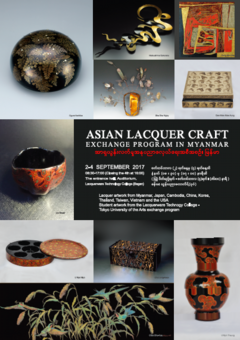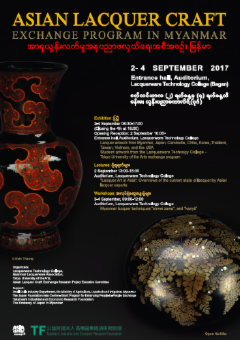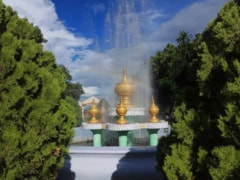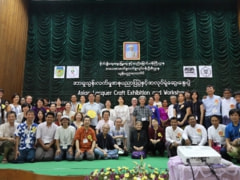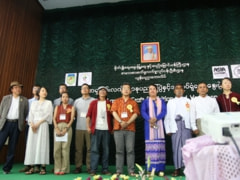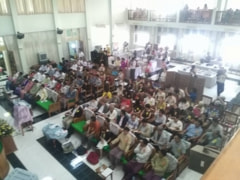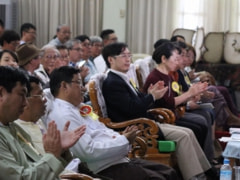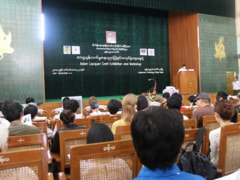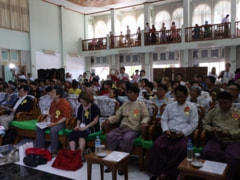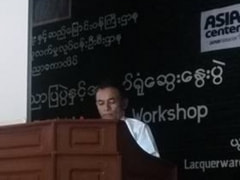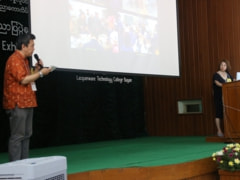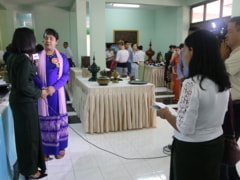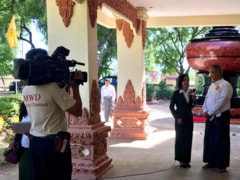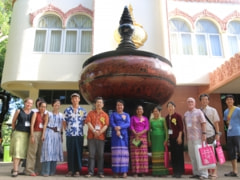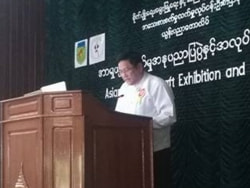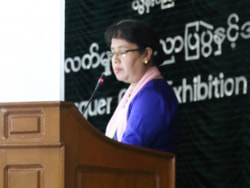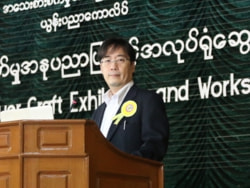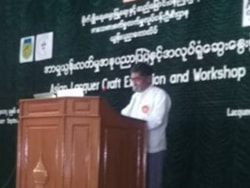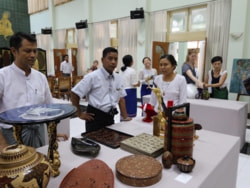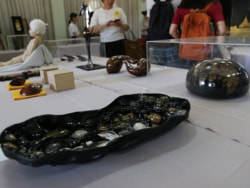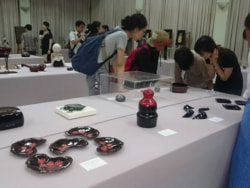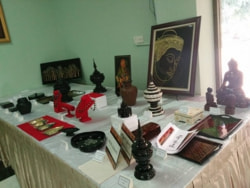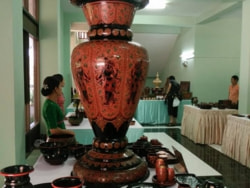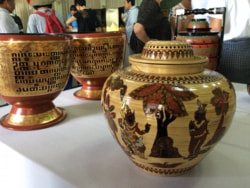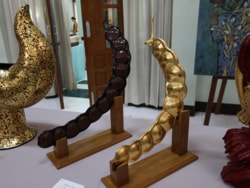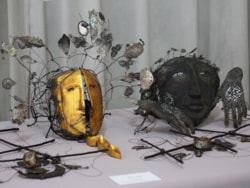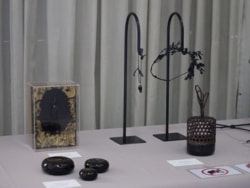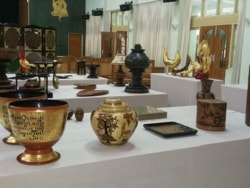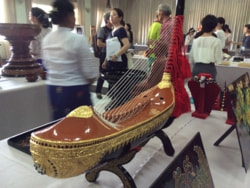Asian Lacquer Craft Exchange Program, in Myanmar, 2017
“Asian Lacquer Art Exhibition in Myanmar”
Lacquerware Technology College
Open: 2 ~ 4 September (8:30~17:00)
Over 100 lacquer art works from Myanmar, Japan, Cambodia, China, Korea, Taiwan, Thailand, Vietnam and USA were exhibited.
日本•ミャンマー•ベトナム•タイ•ラオス•カンボジア•中国•韓国•台湾•米国等の国と地域の漆作品約100点を展示いたしました。
At the Museum of Fine Arts, lacquer artworks from Vietnam, Japan, Cambodia, China, Korea, Myanmar, Taiwan, Thailand, the UK, and the USA were exhibited. A wide variety of expressive works using diverse designs and techniques were showcased. Text panels explaining the current state of lacquer arts and crafts in each country were displayed along with the art works. Many Vietnamese lacquer painters, artists, artisans as well as foreign residents, tourists and people interested art and Japanese culture visited the exhibition.
ARTISTS
Myanmar
Lacquerware Technology College
Daw Aye Aye Mar, Daw Ei Ei Han, U Htay Aung, U Kyaw Kyaw Win, U Myint Khaing, U Soe Min Khaing, Daw Su Su Myint, Daw Swe Swe Myint, Daw Thwe Thuzar Sint, Daw Tin Mar Win, U Tin Win, U Win Naing, U Zaw Naing, Research and Development Department
Myanmar Lacquerware Association
U Aung Kyaw Htun, Daw Aye Aye Nwe, U Hla Htun, U Htin Aung Zaw, U Ko Ko Maung, U Kyin Thaung, U Maung Aung Myin, U Maung Maung, Daw Maw Maw Aung, Daw Moe Moe, U Myo Min Oo, U Myo Myo, U Soe Moe Thet, U Soe Myint, U Thein Htun, U Tin Htun
Japan
Ako Kanae, Akutsu Mami, Imai Miyuki, Inami Jun, Kamigaki Natsuko, Koizumi Takumi, Li Peipei (China), Mashiyama Akie, Matsumoto Mana, Matsushima Sakurako, Nakamura Saki, Nakano Chisato,
Ogawa Taro, Ogura Norihiko, Okukubo Kiyomi, Oya Kazunari, Tanakadate Ami, Watanabe Shusei, Yamaoka Runa, Yasui Tomoyuki
Southeast Asia
Cambodia - Eric Stocker (France),
Thailand - Lipikorn Makaew, Phumrapee Kongrit, Rush Pleansuk, Sumanatsya Voharn
Vietnam - Ando Saeko (Japan), Cong Kim Hoa, Trinh Tuan
China
Hua Mengtian, Jin Hui, Liu Shuai, Liu Yi, Pan Minghui, Weng Jijun, Xu Rui, Xu Yue, Zhang Bin
Korea
Choi Jong-kwan, Chung Bok-sang, Chung Young-hwan, Jung Myung-che, Jung Yong-ju, Kim Ha-won, Lee Ha-young, Sung Yong
Taiwan
Chen Shu-hwa, Lin Shing-ann
USA
Sha Sha Higby
Opening Ceremony and Events
10:00~ 2 September
Greeting 開会に寄せて
Sakurako Matsushima, Director, Asian Lacquer Craft Exchange Research Project
Opening Remarks 開会の儀
U Mya Than: Director General, Small Scale Industries Department, Ministry of Agriculture, Livestock & Irrigation
Mr. Toshimichi Koga: First Secretary, Head of Information and Culture Section, The Embassy of Japan in Myanmar
Daw Nilar Myint: Principal, Lacquerware Technology College
U Maung Maung: Chairman, Myanmar Lacquerware Association
An Overview of the Lacquerware Technology College, Daw Nilar Myint, Principal, Lacquerware Technology College, Bagan
Lacquerware Technology College was established as the Government Lacquerware Training School on 1924. After the enhancement of the lacquer subjects, the school was upgraded to the Myanmar Lacquerware Institute and Lacquerware Technology College. In 2016, a two-year higher Lacquerware technology training course was reopened to teach basic lacquer education to the successful secondly level students to provide craftsmen for the regional lacquer industry. In addition, the College opened a short term lacquerware training course. In 2017, a laboratory was established to do research into the raw materials used in Lacquerware products and to analyze pigments. The main aim of the laboratory is to support lacquer craftsman and lacquer businessmen. The Lacquerware Technology College is carrying out collaborations with International Lacquer Technicians to develop and improve regional Lacquerware production.
Lectures
2 September (11:10-12:00, 13:00~15:20) Auditorium, Lacquerware Technology College
11:10 – “Lacquer Education in Asia”: Educators from Japan, China, Korea, Thailand, and Vietnam
日本, 中国, 韓国, タイ, ベトナムの大学漆芸教育者による各大学の漆教育についての紹介を行った。
Moderator: Dr. Itani Yoshie
Japan - Ogura Norihiko, Professor, Tokyo University of the Arts / Yasui Tomoyuki, Lecturer, Kyoto City University of Arts / Ogawa Taro, Lecturer, Toyama University
China - Jin Hui, Professor, Shanghai University
Korea - Jung Yong-ju, Professor Emeritus, Yeungnam University
Thailand - Sumanatsya Voharn, Lecturer, Chiang Mai University
Vietnam - Trinh Tuan, Lecturer, University of Industrial Fine Arts, Hanoi
13:00 – Overview of the Asian Lacquer Craft Exchange Research Project
Sakurako Matsushima, Director, Asian Lacquer Craft Exchange Research Project
“アジア漆工芸交流事業について”, 松島さくら子, アジア漆工芸学術支援事業代表
13:15 - Lacquer in Myanmar
Myanmar Lacquer Arts, U Maung Lin, Head of Department, Lacquerware Technology College
“ミャンマーの漆工芸” ウ マウン リン, 漆芸技術大学
In Myanmar, there is evidence that Lacquerware production began in the Bagan Era (12th century). From the 16th century through the 19th and early 20th centuries, Lacquerware production gradually increased and quality improved. Previously, there were more than 35 Lacquerware production centers. Today, however, there are only about five centers left that continue production and most are depended upon market conditions and use less skilled workers. Bagan, the ancient capital, was and is the place most visited by local and foreign travelers. Therefore, Lacquerware production is more developed and of high quality due to market demands, but is also facing the issue of maintaining a skilled labor force. In addition to the high-quality traditional lacquerware produced in Bagan, modern design has also improved. Lacquer businessmen, craftsmen, and labors need to cooperate to better develop lacquerware production in Bagan.
13:40 - Lacquer in Japan,
”Japanese Lacquer–Maki-e & Raden”, Norihiko Ogura, Professor, Tokyo University of the Arts
“日本の漆工芸-蒔絵と螺鈿”, 小椋範彦, 東京藝術大学教授
“Maki-e” is the traditional Japanese decorative technique of sprinkling gold or silver powder on lacquerware. First, urushi (lacquer) is applied to the areas to be decorated and then the powder is sprinkled over these areas before the urushi hardens. The Maki-e technique was originally developed in Japan and has 1300-year history.
“Raden” is another decorative technique in which linings of mother-of-pearl, abalone, or great green turban shells are cut into designs and either put onto or inserted into the lacquered surface. Professor Ogura talked about several maki-e and raden decorative techniques.
14:20 -”Lacquer Art in Asia”: Lacquer experts from Thailand, Vietnam, Laos, Cambodia, and Korea
“アジアの漆工芸”: 各国の漆工芸の現状, タイ•ベトナム•ラオス•カンボジア•中国•韓国の専門家
Cambodia - Eric Stocker (Ken Dillon)
Historically, Cambodia had a thriving lacquer industry and culture. But the industry and technical skills were lost in the upheavals of recent times. However today, lacquer trees (Gluta Usitata) are being tapped in Kampong Thom province and lacquerware using natural lacquer is being made in Siem Reap. More artisans are recognizing the beauty of natural lacquer and are exploring its possibilities. There has been a rebirth of lacquer culture in Cambodia.
China - Jin Hui
At present, Chinese handicrafts is in a golden age: The state has formulated many policies to support arts and crafts. The National Ministry of Culture is providing generous funding to promote lacquer arts and other crafts. One by one, universities have established lacquer art studios, and recently, the Tenth University Handicrafts Exhibition was held. Some cities, such as Wuhan, Fuzhou, have held a series of international lacquer art exhibitions. Lacquer has become a cultural card. The Chinese Lacquer Painting Artists Association Committee also held a number of Academic Exhibitions. With these developments, more and more people are paying attention to lacquer arts.
Korea - Jung Yong-ju (Kim Ha-won)
Lacquer, also known as the 'Asian mystery', is an entirely natural and environmentally friendly coating material. Processed from sap harvested from the lacquer tree, it possesses unique aesthetic and physical properties that have been exploited in Asian arts and crafts for several millennia. With its unique technique, the Korean tradition of lacquer work with mother-of-pearl inlay is without doubt one of the summits of lacquer arts worldwide. Lacquer withstands long years of use and has a variety of expressive techniques. This is undoubtedly the most excellent nature-friendly material that can open a new chapter of ingenious lacquer formative art when incorporating it into contemporary formative art.
Laos - Jacinta Brown
Lacquer in Laos: two steps forward, one step back.
Lacquerware in Laos has had a difficult path. Nearly lost as an art form, the recent increase in prosperity in Laos and promotion of lacquer artisans through government initiatives has boosted interest and production of lacquerware in Laos. Buddhism related offering bowls have become particularly popular among locals and for the tourism market. While there are many supporters of Lao lacquer, it must compete against fakes and imports and the continuation of the art form is uncertain at present.
Thailand - Sumanatsya Voharn
Lacquer sap (Gluta usitata) has been used since ancient times to strengthen and protect bamboo and wooden objects. In the north where the tree is common, sophisticated techniques were developed and lacquerware handicrafts became an important industry. Traditional design motifs were of usually of Buddhist beliefs and myths. Today, however, the industry is in decline. Factories churn out low quality products for tourists mostly using chemical varnishes and acrylics. Traditional techniques need to be passed on to younger generations who need to use them in contemporary artistic expression. Lacquer arts and crafts needs to be introduced at art education institutions.
Vietnam - Trinh Tuan
Lacquer art in Vietnam can be divided into two genres, do son, lacquer crafts and son mai, lacquer painting. Do son include tableware, furniture, and Buddhist statues. Unfortunately, with the advent of modern mass production, chemical varnishes replaced natural lacquer in most craft industries. Son mai, however, still flourishes as an art form. Colonial schools introduced Western style painting. Local artists then began using lacquer sap (T. succedaneum) in paintings, creating a new art form. Being uniquely Vietnamese increased its visibility and many young artists became lacquer painters. Lacquer is not an easy medium to work in; therefore, master artists need to hand down to younger generations the techniques that they learned over time.
